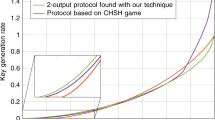Abstract
We treat secret key extraction when the eavesdropper has correlated quantum states. We propose quantum privacy amplification theorems different from Renner’s, which are based on quantum conditional Rényi entropy of order 1 + s. Using those theorems, we derive an exponential rate of decrease for leaked information and the asymptotic equivocation rate, which have not been derived hitherto in the quantum setting.
Similar content being viewed by others
References
Ahlswede R., Csiszár I.: Common randomness in information theory and cryptography part 1: Secret sharing. IEEE Trans. Inform. Theory 39(4), 1121–1132 (1993)
Bennett C.H., Brassard G., Crepeau C., Maurer U.M.: Generalized privacy amplification. IEEE Trans. Inform. Theory 41, 1915–1923 (1995)
Håstad J., Impagliazzo R., Levin L.A., Luby M.: A pseudorandom generator from any one-way function. SIAM J. Comput 28, 1364 (1999)
Renner, R., Wolf, S.: Simple and Tight Bounds for Information Reconciliation and Privacy Amplification, ASIACRYPT 2005, Lecture Notes in Computer Science, vol. 3788: SIAM J. Comput. pp. 199–216 (2005)
Hayashi M.: Exponential decreasing rate of leaked information in universal random privacy amplification. IEEE Trans. Inf. Theory 57(6), 3989–4001 (2011)
Renner, R.: Security of Quantum Key Distribution, Ph.D. thesis, Dipl. Phys. ETH, Switzerland (2005). arXiv:quantph/0512258
Matsumoto, R., Hayashi, M.: Universal Strongly Secure Network Coding with Dependent and Non-Uniform Messages (2011). arXiv:1111.4174
Hayashi, M.: Large deviation analysis for classical and quantum security via approximate smoothing (2012). arXiv:1202.0322. Accepted for IEEE Transactions on Information Theory
Watanabe, S., Hayashi, M.: Non-Asymptotic Analysis of Privacy Amplification via Renyi Entropy and Inf-Spectral Entropy. In: 2013 IEEE International Symposium on Information Theory (ISIT 2013) Istanbul, Turkey, pp. 2715–2719. 7–12 July 2013
Hayashi M.: Second-order asymptotics in fixed-length source coding and intrinsic randomness. IEEE Trans. Inf. Theory 54, 4619–4637 (2008)
Tomamichel M., Hayashi M.: A hierarchy of information quantities for finite block length analysis of quantum tasks. IEEE Trans. Inf. Theory 59(11), 7693–7710 (2013)
Wyner A.D.: The wire-tap channel. Bell. Syst. Tech. J. 54, 1355–1387 (1975)
Csiszár I., Körner J.: Broadcast channels with confidential messages. IEEE Trans. Inform. Theory 24(3), 339–348 (1978)
Marina, N., Yagi, H., Poor, H.V.: Improved Rate-Equivocation Regions for Secure Cooperative Communication. arXiv:1102.3500. In: Proceedings of the 2011 IEEE ISIT St. Petersburg, Russia, July 2011, pp. 2871–2875
Shafee, S., Ulukus, S.: Achievable Rates in Gaussian MISO Channels with Secrecy Constraints. In: Proceedings of the 2007 IEEE ISIT, Nice, France, June. pp. 2466–2470 (2007)
Xu, J., Chen, B.: An outer bound to the rate equivocation region of broadcast channels with two confidential messages. In: Proceedings of the Global Telecommunications Conference, 2008. IEEE GLOBECOM 2008. New Orleans, LA, USA, pp. 1–5, Nov–Dec 2008
Liang Y., Poor H.V.: Multiple-access channels with confidential messages. IEEE Trans. Inform. Theory 54(3), 976–1002 (2008)
Oggier, F., Hassibi, B.: The secrecy capacity of the MIMO wiretap channel. In: Proceedings of the 2008 IEEE ISIT Toronto, Canada, pp. 524–528. July 2008
Ozel, O., Ulukus, S.: Rate-equivocation region of cyclic shift symmetric wiretap channels. In: Proceedings of the 49th Annual Allerton Conf. Allerton House, Monticello, IL, USA, pp. 1120–1127 (2011)
Andersson M., Rathi V., Thobaben R., Kliewer J., Skoglund M.: Nested polar codes for wiretap and relay channels. IEEE Commun. Lett. 14(8), 752–754 (2010)
Hayashi, M., Matsumoto, R.: Universally attainable error and information exponents, and equivocation rate for the broadcast channels with confidential messages. In: Proceedings of the 49th Annual Allerton Conf. Allerton House, Monticello, IL, USA, pp. 439–444 (2011)
Choo, L.-C., Ling, C., Wong, K.-K.: Achievable rates for lattice coded gaussian wiretap channels. In: Proceedings of the IEEE International Conference on Communications Workshops (ICC), pp. 1–5. June 2011
Rathi, V., Urbanke, R., Andersson, M., Skoglund, M.: Rate-equivocation optimal spatially coupled LDPC codes for the BEC wiretap channel. In: Proceedings of the 2011 IEEE ISIT Saint-Petersburg, Russia, pp. 2393–2397, Aug 2011)
Fujii J.I., Kamei E.: Relative operator entropy in noncommutative information theory. Math. Japon. 34, 341–348 (1989)
Belavkin V.P., Staszewski P.: C*-algebraic generalization of relative entropy and entropy. Ann. Inst. Henri Poincaré, Sec. A 37, 51–58 (1982)
Hiai F., Petz D.: The proper formula for relative entropy and its asymptotics in quantum probability. Commun. Math. Phys. 143, 99–114 (1991)
Hayashi M.: Quantum Information: An Introduction. Springer, Berlin (2006)
Hayashi M.: Optimal sequence of POVMs in the sense of Stein’s lemma in quantum hypothesis. J. Phys. A: Math. Gen. 35, 10759–10773 (2002)
Carter L., Wegman M.: Universal classes of hash functions. J. Comput. Syst. Sci. 18(2), 143–154 (1979)
Krawczyk, H.: LFSR-based hashing and authentication. Advances in Cryptology—CRYPTO ’94 Lecture Notes in Computer Science, vol. 839, pp. 129–139. Springer, Berlin (1994)
Devetak I., Winter A.: Distillation of secret key and entanglement from quantum states. Proc. R. Soc. Lond. A 461, 207–235 (2005)
Hayashi M.: Tight exponential analysis of universally composable privacy amplification and its applications. IEEE Trans. Inf. Theory 59(11), 7728–7746 (2013)
Frank R.L., Lieb E.H.: Monotonicity of a relative Renyi entropy. J. Math. Phys. 54(12), 122201 (2013)
Muller-Lennert M., Dupuis F., Szehr O., Fehr S., Tomamichel M.: On quantum Renyi entropies: a new generalization and some properties. J. Math. Phys. 54, 122203 (2013)
Wilde M.M., Winter A., Yang D.: Strong converse for the classical capacity of entanglement-breaking and Hadamard channels via a sandwiched Renyi relative entropy. Commun. Math. Phys. 331(2), 593–622 (2014)
Mosonyi, M., Ogawa, T.: Quantum hypothesis testing and the operational interpretation of the quantum Rényi relative entropies. arXiv:1309.3228
Author information
Authors and Affiliations
Corresponding author
Additional information
Communicated by A. Winter
Rights and permissions
About this article
Cite this article
Hayashi, M. Precise Evaluation of Leaked Information with Secure Randomness Extraction in the Presence of Quantum Attacker. Commun. Math. Phys. 333, 335–350 (2015). https://doi.org/10.1007/s00220-014-2174-y
Received:
Accepted:
Published:
Issue Date:
DOI: https://doi.org/10.1007/s00220-014-2174-y




